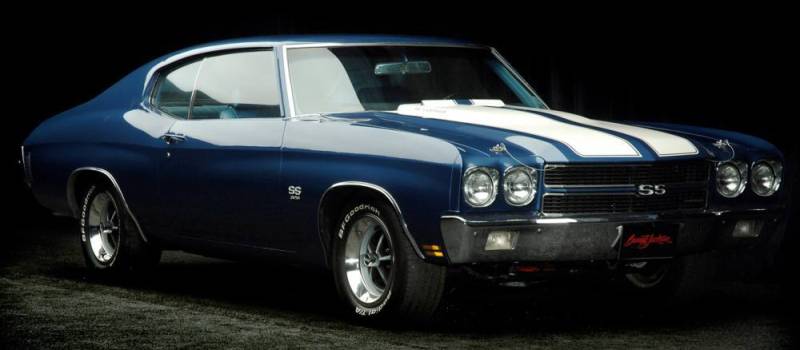A 1970 Chevelle and a 1966 Corvette recently appeared in the news after both car’s owners were charged with felonies for trying to create and sell fake ‘numbers matching’ cars. With big money changing hands for collectible cars around the country these days, the activity can attract unscrupulous people and high profile cars at high prices just make it more tempting. All classic car enthusiasts should take note that this scenario is becoming a lot more common than one might imagine and it is always up to the buyer to research a car’s documentation before laying down any cash.
The Chevelle in question was a SS 396 that was purchased for $37,500 by Mickey Dush of Columbus, Nebraska. Dush equipped it with a fake build sheet, outfitted it with a 454, and then sold it to an Iowa man as an LS6 car for $87,000. Sometime after the sale the new owner’s wife ran the VIN numbers and determined the car had a fake build sheet and was overpriced by about $50,000. The second car, a 1966 Corvette, was purchased as a 427 convertible for $49,700 by Robert Ernst of North Tonawanda, New York. Ernst later took his Vette to a National Corvette Restorers Society meet where he hoped to obtain certification that reflected the $75,000 he had invested in recent restoration. Instead, he was disqualified because his VIN tag was found to be counterfeit. The number was right for the car, but the VIN tag itself was a fake. The amount of monetary damage is difficult to ascertain in this case because it involves a car that is basically correct, but one that is not certified or showable at certain events.
For his efforts, Mickey Dush is looking at up to 20 years in prison. If a deal is too good to be true, you can assume it is . Hiring an expert to make sure a car is authentic before you advance any cash is always a good idea and far cheaper than being on the losing end of a high-dollar scam. The problem of faked documentation is not confined to high-end classics or high-performance cars either, as frequent turnovers and auction frenzies have driven up the prices of nearly all classic cars, and have made it worth faking the paperwork or certain features for a quick profit. Plus, the technology now exists that makes it possible to replicate both documents and the coded factory stampings on the hard parts of just about any car.
Although false documentation or numbering might not make a huge difference on mid-value hobbyist vehicles, it can translate to many thousands of dollars on the most collectible, high-end cars. Regardless of the value of a potential purchase, buyers should always ask to see the title before negotiating a deal. Unless the title and VIN are correct and the seller actually has legal ownership, there’s no need to proceed with a deal at all. Likewise for cars that have “rebuilt” or salvage titles; including those with liens. A title search should also reveal if a car has been stolen at some point in its history. Documentation is especially important for GM cars produced before 1969 because the VIN codes, casting dates and date-coded parts were not computer indexed until after that year. Another paperwork problem is the fact that there has never been any system of national registration in the U.S. and older cars have their histories kept in the registration files of 50 different states. Many of those states purge their files after 10 or so years of non-registration and it is not uncommon for an older GM car to show up for sale with a recent registration as its’ only history. The lack of official paper histories for so many vintage GM vehicles has resulted in the proliferation of many “non-official” and newly created fraudulent histories. This can lead to problems when a guy researching his 1965 Chevelle with the L-79 350 engine learns that GM only built 6,021 cars exactly like his…and there are over 8,000 registered on the road today.
There are companies online that can research a car you are looking at, however many only work with recent, non-vintage cars. Some states have motor vehicle divisions that offer free vehicle registry services to check out a vehicles’ paperwork trail, but only if there is a trail to follow. The state registries are limited to the information they can collect and can be inaccurate and incomplete when it comes to vintage vehicles. Various enthusiast car clubs and associations also maintain registration databases for their members, although many are limited to certain regions of the country or specific vehicles. A good avenue of independent research for many vintage GM vehicles is available in the form of “numbers & codes” reference books (available at OPGI.com) that identify and list specific cars and parts. Gathered from original source material, engineering blueprints, technical service bulletins and build sheets, the “numbers” books can be very useful resources for dating and deciphering a car’s origin and original equipment specifications.
The buyer’s task of establishing the true identity of a 1970 Chevelle like the one sold by Mr. Dush would have been greatly simplified with access to a resource such as the 1964-72 Chevelle Numbers & Codes Book containing 102 pages of Chevelle casting numbers, suffix codes, VIN codes, transmission codes, rear axle codes, part numbers and production totals. The same goes for many of the other good reference books available from OPGI including 1965-69 Chevrolet by the Numbers, 1970-75 Chevrolet by the Numbers, 1955-93 Catalog of Chevy V8 Engine Casting Numbers, and Chevy Cowl Tag Identifications. You simply can’t have too much information when it comes to buying or selling classic cars. Knowledge is power, and in the end it is the buyer’s responsibility to do the homework necessary to avoid the financial loss and embarrassment that comes with being the victim of a preventable scam.

